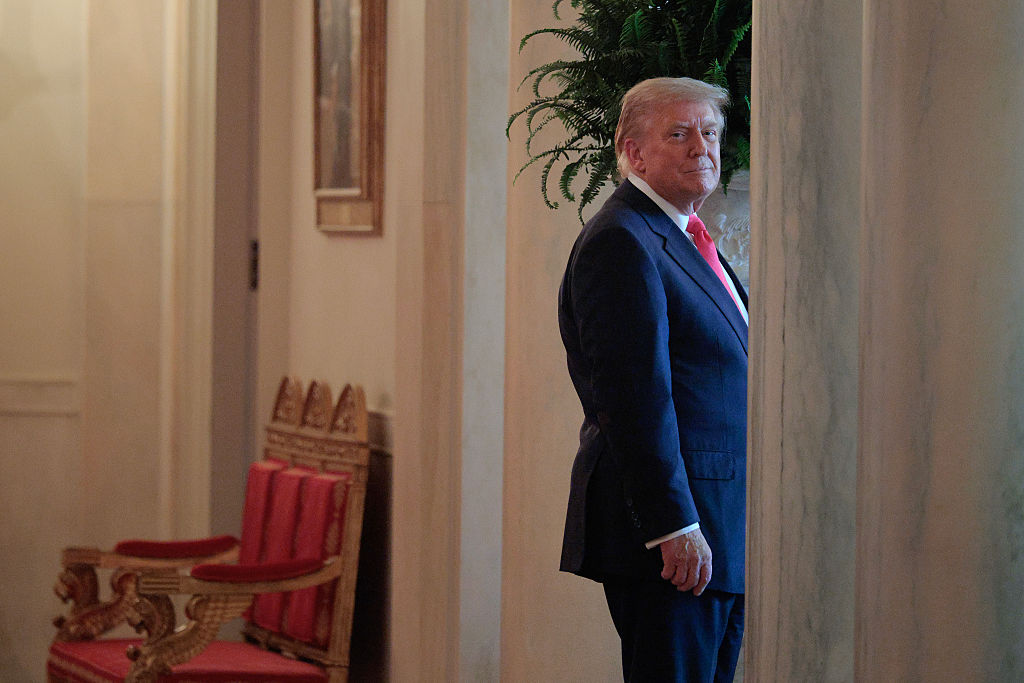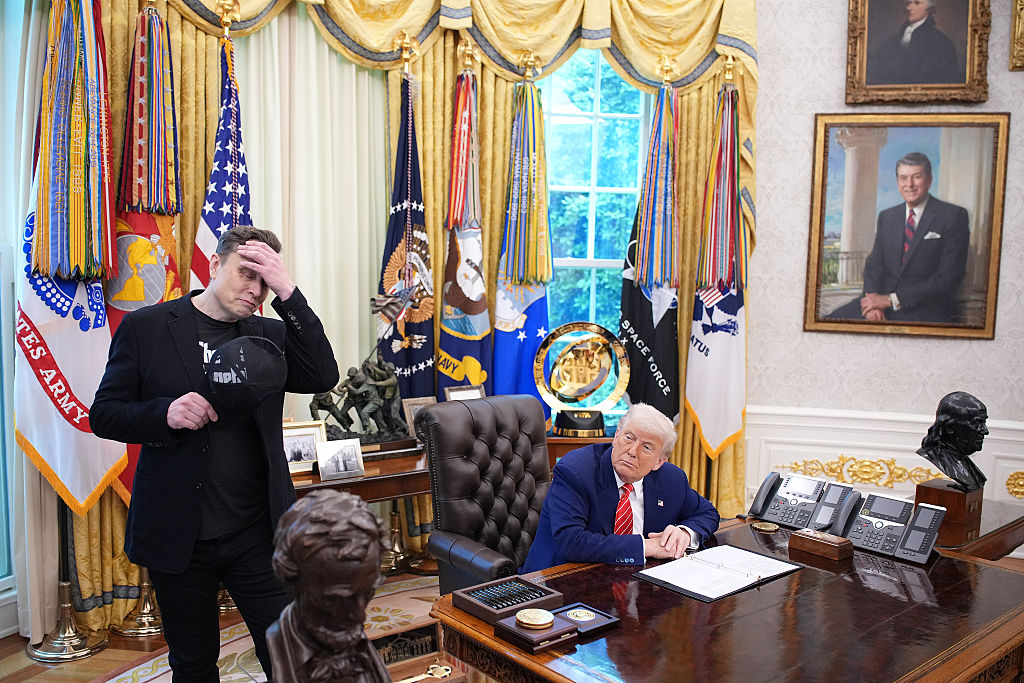It is an irony of history that the bronze Statue of Freedom which stands tall atop the US Capitol dome was commissioned by the man who would seek to break the nation apart a few years later. Jefferson Davis, secretary of war when the statue was ordered, clashed with Yankee sculptor Thomas Crawford over his original design, which included a liberty cap, the symbol of an emancipated slave, above the statue’s crown. The statue is adorned with a sword, a shield and a wreath of victory. It’s symbolic in other ways as well: struck hundreds of times by lightning, it conducts and dissipates that violent energy into the earth. Freedom makes an excellent lightning rod.
Today, critiques of the statue and what it represents arise from different sources. Speaking just before the 2022 election, Professor Mary Imparato of Belmont Abbey College recalled a trip to Washington with fellow Catholic students. One of them, “gazing up at the illuminated Capitol building, said: ‘Wouldn’t it be amazing if one day that statue on top were replaced by Our Lady?’ ‘Yeah, that would be awesome,’ I agreed.” She described the incident as showing that she was “an integralist before I even knew what the word meant.”
Imparato’s comments came in a panel on “What’s New About the New Right,” at the ambitiously named “Restoring a Nation Conference” convened by a group of academics and intellectuals of the “post-liberal” movement at the Franciscan University of Steubenville. They serve as a perfect example of the limitations that version of the “New Right” has encountered. It’s now clear to the intellectual cohort that sought to turn the rise of Donald Trump into an ambitious realignment — of politics, policy and culture — that their efforts have been frustrated by reality. The oft-decried “zombie Reaganism” of fusionist politics has not been replaced by a coming-together of the economic left and socially conservative right. Maybe, hope the realigners, the consensus wasn’t dead yet — perhaps it was just pining for the fjords.
From the beginning, the forces of realignment have assumed too much about the inevitability of their project
After the disappointing 2022 midterm elections, which saw multiple realignment-sympathetic candidates fail, Catholic intellectual Gladden Pappin, one of the chief organizers of the Steubenville conference, penned a nearly 6,000-word essay in the journal American Affairs.
In “Requiem for the Realignment” Pappin observes, “Since the election of Donald Trump in 2016, many on the right have preached the advent of a ‘realignment.’ Accounts of realignment have taken various forms, but generally involve some traditionally Democratic constituencies shifting to the Republican Party and the GOP itself beginning to reflect the populist priorities of its base.” Citing the 2019 declaration “Against the Dead Consensus,” he continues: “Calls for realignment on the right are even more urgent now than they were five years ago. But they are currently on very precarious ground, and only an honest reckoning with that fact can keep the possibility of realignment alive.”
No one has come up with “a positive governing agenda that would use the power of the state to bolster the national industrial economy and support the American family,” Pappin writes. While certain groups (including his own) have developed arguments to back such ideas, “they aren’t being translated for the electorate as a whole.” Pappin blames this problem on the inadequacy of “the typical conservative approach to governance,” the abiding fiscal conservatism of the Republican Study Committee on Capitol Hill, and Republican objections to Joe Biden’s unconstitutional student-loan debt forgiveness — instead, he argues, the GOP should favor a Hungary-like debt cancellation approach. (He is a visiting senior fellow at the Mathias Corvinus Collegium in Budapest, along with several of his ideological allies.)
Pappin is not at all happy, however, with some of his putative allies. His essay repeatedly criticizes not the failure of green candidates or the expenditures of political groups, but the Heritage Foundation’s new president, Kevin Roberts, apparently for the sin of sticking to a fundamental, if dusty, conservative line: “Government is not the solution, but the obstacle, to our flourishing.” To Pappin, Roberts’s platitude signifies that Heritage is interested in mere lip service to the New Right — despite the fact that a Catholic and populist himself, Roberts is undeniably the most national-conservatism-friendly figure in the world of large think tanks. But in the realignment framing, the old must be swept away so the new can dominate.
I reached out to an accomplished campaign consultant who has elected multiple nationalist-conservative or “New Right” candidates. “This is written by a person who obviously is not a combatant and never has been, almost like he has been watching politics and policy from a distant library somewhere,” he told me. “It’s foolish to believe that all these groups, think tanks, new movements, and self-described ‘important conservative groups’… that he should take them seriously, or that they impact anything. This entire piece, including the polling that he cites, is primarily fiction.”
One abiding element of the realignment’s failure is the strangely unmerited self-importance of the New Right
From the beginning, the forces of realignment have assumed too much about the inevitability of their project. The arrival of the Trumpian moment in 2016 appeared to be a golden opportunity for dissatisfied conservatives: if you disliked old-guard, big-business Republicanism, Tea Party fiscal policy or the hawkish GOP foreign-policy establishment, you hoped the post-Trump GOP could become the vehicle for… well, whatever it was you’d always wanted. Instead of championing military spending and confrontation with Russia and China, the GOP would turn dovish. Instead of being the party of the Chamber of Commerce and Right to Work, it would become the party of more powerful unions; instead of touting supply-side economic policy that sought to cut back on entitlements and lower taxes, it would consider joining with the left to fund bigger social programs with taxes on the wealthy. Yet their endeavor took shape as an approach utterly at odds with the populist nature of its aspirations. Rather than engage in a popular activist project like the Tea Party, the “realignment” appeared to be designed around think tanks and panels and long, overwritten essays. It was as if the nerds had decided that the way to guide the conservative movement away from the orthodoxy of the Wall Street Journal’s editorial page was through the op-ed pages of the New York Times.
One abiding element of the realignment’s failure is the strangely unmerited self-importance of the New Right. They have elected almost no one who espouses their views — not even Donald Trump. (If you come out of a friendly electoral cycle where you espoused your popularity and inevitability by adding one sympathetic senator in J.D. Vance, that’s typically viewed as a failure.) They talk about Hungary as if it were self-evidently the way of the future (many of them while accepting payment from said country’s government), seemingly unaware that this is something no actual American conservative voter they claim to speak for will point to as an aspiration. All their talk of the “return of the strong gods” and a “based MAGA majority” is characteristically unintelligible — and at odds with reality. In March, a Wall Street Journal poll suggested that young Americans’ only real priority anymore is money — a depressing but powerful rejoinder to their argument that things are moving inevitably in the New Right’s direction. And yet they act like teenagers in a creative writing class, convinced they’ve already written the best screenplay ever and have nothing to learn.
Like wokeism on the left, the battle over the realignment is a fight between a small number of weird, rich, mostly white extremists
The New Right are trying to persuade political elites, thereby hoping that they can impose their ideas on the movement, the party, and the country in short order. Like wokeism on the left, the battle over the realignment is a fight between a small number of weird, rich, mostly white extremists. Nobody cares about Hungary as a model for the American right any more than they care about Maduro as a model for the American left. It all amounts to a tempest in a red Solo cup — not that most New Right intellectuals would get that reference.
Nevertheless, a whole cohort of academics, commentators, intellectuals, policy experts and would-be thought leaders began building up the case for their desired realignment. They founded journals, wrote essays, recorded podcasts, organized open letters to no one in particular, and hosted many, many conferences where overlapping groups of people gathered to give each other awards. And as intellectuals do, along the way they engaged in fractious, embittered and largely pointless personal feuds.
The tension in Steubenville between the Catholic integralists and “natcons” from the influential National Conservatism conference founded by Israeli author and intellectual Yoram Hazony was immediately apparent. In a Twitter exchange with Pappin afterward, Hazony responded to allegations that natcon gatherings are unwelcoming to the integralists: “It seems that what we have here is a unilateral boycott of natcon by some of the leading ‘Catholic integralists.’ I do think there’s room for some of you to speak at Nat-Con. But my impression is that… you’d rather keep sniping at us from the hills.” Hazony also noted rather sharply that “some of your circle have tilted noticeably in the direction of America’s great strategic rival, China.”
This Sino-curious behavior has been a notable point of contention throughout the realignment cohort, with some praising the Chinese model as a better, more pro-family approach to governance — which hasn’t gone over well with some otherwise open to their domestic ideas, despite the last decade’s indisputable turn of reliably Republican voters against the neoconservative foreign policy associated with George W. Bush.
Yet this change has not, in general, amounted to a GOP coalition calling for a smaller military or less engagement with the rest of the world. Disgust at the embarrassingly botched Afghanistan withdrawal and splits over the level of financial support for Ukraine notwithstanding, elected conservatives and their coalition supporters have shown precious little indication of embracing isolationism or dovishness. They still cheer when terrorists die, they still vote for massive military budgets, and if there is one area of bipartisan consensus in Washington, it’s that you can’t be enough of a hawk on China. According to the latest Pew Research poll, 82 percent of Americans and 89 percent of Republicans have unfavorable views of China — views that could be put to the test over Taiwan soon enough.
Other episodes of infighting have demonstrated the realigners’ lack of street-smarts. Last summer, a prominent trio of pro-life Catholic integralists took to the New York Times to unleash bile against the Federalist Society, decrying it as an ineffective entity that had not delivered on its promises to support legal originalism, instead becoming just one more piece of a decrepit “Conservatism, Inc.” that included the Heritage Foundation, the Hudson Institute and the National Review Institute — defenders, the writers said, of corporatism and neoliberalism instead of the social conservative priorities they claimed to uphold. “This is what the conservative movement became, the jackals of Mammon. And it is what threatens the common good of the nation,” the authors wrote.
It was a frontal attack on the core of the conservative movement that had driven policy, staff and priorities from the rise of Ronald Reagan to the Newt Gingrich revolution and beyond. And the authors’ timing was almost comically inept: two days later, Roe v. Wade was struck down by the very justices the Federalist Society had backed for the Supreme Court — the single greatest victory for “Conservatism, Inc.” in its entire history.
The realigners had another problem, too. The people most interested in funding a realignment that would move away from the pro-capitalist, limited government, fiscally conservative roots of modern Republicanism tend to have other priorities. Instead of calling on the grassroots small donors favored by Tea Party groups a decade earlier, organized realignment efforts found funding from leftist sources focused explicitly on accelerating the end of “neoliberalism.” And as activists know, a shift in donor base inevitably leads to a shift in priorities.
The Ford, Hewlett and Omidyar foundations, which have already been giving to these causes for some time, announced a commitment to half a billion in giving over the coming five years. The “Reimagining Capitalism” effort, funded by Hewlett and Omidyar, is spending tens of millions of dollars not just on the typical leftist groups, but on several groups that consider themselves on the right. It’s surprising to fund American Compass, founded by former Mitt Romney advisor Oren Cass, at the same time you’re funding Planned Parenthood — but not impossible.
Among the friends of the realignment movement, or those who want to see it become, as the Tea Party eventually did, ingrained within a broader coalition of the right, there is disagreement about the true reasons for its failure. Some cite the abiding resistance of ideological conservatives to government spending on any social programs at all: some such initiatives, like the monthly child tax credit, have backers on the right as well as elsewhere. Others think there’s a problem in the failure to distinguish a more general turn against big business from a turn against woke “diversity equity inclusion” facets of big business, particularly in Silicon Valley. Still others say that President Biden’s Rust Belt-focused messaging, which embraces big-spending industrial policy, has coopted GOP support for such outreach and made it anathema among Capitol Hill conservatives.
One astute observer of national politics, supportive of the New Right’s goals, told me he believes the real fault is the lack of a single clear legislative victory. Until those focused on realignment are actually able to shift the internal priorities of enough Republicans and Democrats so such legislation is achievable, politicians will revert to their prior assumptions about the ways coalitions work and voters behave.
Yet for critics of the New Right’s approach, that story about replacing the Freedom statue with Our Lady may be a useful landmark, echoing as it does the recurring arguments about national divorce. In place of the compromise and statesmanship Harry Jaffa saw as Abraham Lincoln’s lesson, the realigners seek to revive the governing philosophy of John C. Calhoun, envisioning a future where government power is used to achieve what they alone define as the “common good.”
There is a major difference between these approaches, of course. Lincolnian democracy is an unending exercise in mass persuasion. Calhounian democracy is an exercise in faction management. It’s the difference between win-win and zero-sum — and Americans feel and know the difference. It’s the difference between dissipating the energy of a lightning strike, and letting everything burn instead.
This article was originally published in The Spectator’s May 2023 World edition.

























